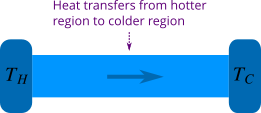Heat is the energy transferred and can be transferred in three different ways which are conduction, convection and radiation. We describe these three mechanisms of heat transfer in brief. But before that you should remember that heat is always transferred from hotter region to colder region.
Heat transfer by conduction
Heat conduction can take place within the same body or two bodies in contact with each other due to temperature difference. In heat transfer by conduction between two systems or bodies the two bodies considered should be in contact with each other. You obviously know that heat transfers from hotter region of a body to colder region of the same body or the other body in contact with it. It means in conduction the heat is transferred by direct contact. If you have a hot metal rod and another cold metal rod, you can place both in contact with each other (in any way you like) to transfer heat from the hot rod to the cold rod by conduction. But no heat by conduction takes place if you separate them by a distance (in this case another mechanism of heat transfer may be possible).
In microscopic viewpoint the particles in the hotter region have greater kinetic energy than the particles in the colder region. And the particles which have greater kinetic energy impart their kinetic energy gradually to the neighboring particles or the particles in the colder region. This process continues until the system comes in equilibrium.

To again discuss the heat conduction in more detail we consider a rod as in Figure 1. The rod has length \(L\) and cross-sectional area \(A\). The curved surface of the rod is insulated so that no heat can escape the curved surface. Consider that the heat transfers from the left end towards the right end; the left end is hotter than the right end. Therefore, the temperature \(T_H\) at the left end is greater than the temperature \(T_R\) at the right end, that is \(T_H > T_C\). The subscripts \(H\) and \(C\) here mean "hot" and "cold" respectively. When a small quantity of heat \(dQ\) transfers in small time interval \(dt\), the heat current \(H\) is \(H = dQ/dt\). It is found that the heat current \(H\) is directly proportional to the change in temperature \(\Delta T = T_H - T_C\) and the cross-sectional area \(A\), and inversely proportional to the length \(L\) of the rod. So if \(k\) is the proportionality constant called thermal conductivity, the heat current is:
\[H = kA\frac{{\Delta T}}{L} \tag{1} \label{1}\]
The thermal conductivity \(k\) depends on the material used; greater the value of \(k\), greater the thermal conductivity. On the other hand the ratio \(L/k\) is the R-value of a material also called thermal resistance. In terms of thermal resistance \(R\) the heat current is
\[H = A\frac{{\Delta T}}{R} \tag{2} \label{2}\]
Heat transfer by convection
In convection heat is transferred by the flow of material or fluid. In conduction the particles with greater kinetic energy impart kinetic energy to the neighbouring particles of colder region without leaving there positions but in convection whole particles move from one region to another. Convection is the useful mechanism of heat transfer in fluids. Convection of air plays an important role in environment. The hot air has smaller density due to expansion and flows upwards and the cold air flows downwards. Similarly in liquid the hot liquid has smaller density and flows towards the surface while the cold liquid flows downwards (anomalous behaviour of water is neglected here).
Heat transfer by radiation
Other mechanism of heat transfer is radiation. In this case there is no thermal contact between systems and no material flow but the heat is transferred even in empty space by radiation. Radiation is the important mechanism of heat transfer, for example, the Sun radiates energy mostly in the form of visible light which is used as the energy source on the Earth. All materials radiate energy. In room temperature the emitted energy is the infra-red radiation of much longer wavelength. As the temperature of a body increases, the wavelength of radiation emitted by the body decreases. The heat current \(H\) by radiation from a surface is directly proportional to the surface area and the fourth power of temperature \(T\), that is, \(H \propto A{T^4}\). Heat current also depends on emissivity \(e\) which is the ratio of heat current from any surface to the heat current from ideal emitting surface of equal area. The heat current from a radiating surface is
\[H = \sigma eA{T^4} \tag{3} \label{3}\]
where \(\sigma\) is a constant called Stefan-Boltzmann constant whose value is approximately \(5.67 \times {10^{ - 8}}{\rm{W/}}{{\rm{m}}^{\rm{2}}} \cdot {{\rm{K}}^{\rm{4}}}\). The value of emissivity \(e\) lies between \(0\) and \(1\). A material of emissivity \(0\) or \(1\) is ideal. A material having emissivity \(0\) does not radiate or absorb at all but that which has emissivity \(1\) emits or absorbs all radiation possible (because a good radiator is a good absorber). An ideal radiating surface is also the ideal absorbing surface so a material with emissivity \(1\) can absorb all radiation falling on its surface. Such a material that can absorb all radiation is referred to as black body. A good radiator is also a good absorber; if a material emits radiation, it can also absorb radiation. An object within its surroundings also absorbs radiation from its surroundings.
Thermos bottles have silver coatings on inside walls and therefore reflect radiation (not a good absorber) back to the liquid kept in the bottle helping to keep the liquid warm for a long time.






